通过这六点,了解Java线程池的全面(总结上篇)
目录
一 使用线程池的好处
池化技术相比大家已经屡见不鲜了,线程池、数据库连接池、Http 连接池等等都是对这个思想的应用。池化技术的思想主要是为了减少每次获取资源的消耗,提高对资源的利用率。
线程池 提供了一种限制和管理资源(包括执行一个任务)。 每个 线程池 还维护一些基本统计信息,例如已完成任务的数量。
这里借用《Java 并发编程的艺术》提到的来说一下 使用线程池的好处 :
- 降低资源消耗 。通过重复利用已创建的线程降低线程创建和销毁造成的消耗。
- 提高响应速度 。当任务到达时,任务可以不需要的等到线程创建就能立即执行。
- 提高线程的可管理性 。线程是稀缺资源,如果无限制的创建,不仅会消耗系统资源,还会降低系统的稳定性,使用线程池可以进行统一的分配,调优和监控。
二 Executor 框架
2.1 简介
Executor 框架是 Java5 之后引进的,在 Java 5 之后,通过 Executor 来启动线程比使用 Thread 的 start 方法更好,除了更易管理,效率更好(用线程池实现,节约开销)外,还有关键的一点:有助于避免 this 逃逸问题。
补充:this 逃逸是指在构造函数返回之前其他线程就持有该对象的引用. 调用尚未构造完全的对象的方法可能引发令人疑惑的错误。
Executor 框架不仅包括了线程池的管理,还提供了线程工厂、队列以及拒绝策略等,Executor 框架让并发编程变得更加简单。
2.2 Executor 框架结构(主要由三大部分组成)
1) 任务(Runnable /Callable)
执行任务需要实现的 Runnable 接口 或 Callable接口 。 Runnable 接口 或 Callable 接口 实现类都可以被 ThreadPoolExecutor 或 ScheduledThreadPoolExecutor 执行。
2) 任务的执行(Executor)
如下图所示,包括任务执行机制的核心接口 Executor ,以及继承自 Executor 接口的 ExecutorService 接口。ThreadPoolExecutor 和 ScheduledThreadPoolExecutor 这两个关键类实现了 ExecutorService 接口 。
这里提了很多底层的类关系,但是,实际上我们需要更多关注的是 ThreadPoolExecutor 这个类,这个类在我们实际使用线程池的过程中,使用频率还是非常高的。
注意: 通过查看 ScheduledThreadPoolExecutor 源代码我们发现 ScheduledThreadPoolExecutor 实际上是继承了 ThreadPoolExecutor 并实现了 ScheduledExecutorService ,而 ScheduledExecutorService 又实现了 ExecutorService,正如我们下面给出的类关系图显示的一样。
ThreadPoolExecutor 类描述:
//AbstractExecutorService实现了ExecutorService接口public class ThreadPoolExecutor extends AbstractExecutorService复制代码
ScheduledThreadPoolExecutor 类描述:
//ScheduledExecutorService实现了ExecutorService接口public class ScheduledThreadPoolExecutor extends ThreadPoolExecutor implements ScheduledExecutorService复制代码
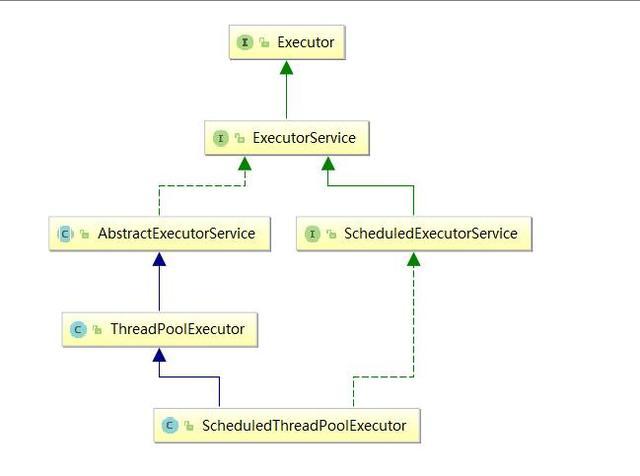
3) 异步计算的结果(Future)
Future 接口以及 Future 接口的实现类 FutureTask 类都可以代表异步计算的结果。
当我们把 Runnable接口 或 Callable 接口 的实现类提交给 ThreadPoolExecutor 或 ScheduledThreadPoolExecutor 执行。(调用 submit() 方法时会返回一个 FutureTask 对象)
2.3 Executor 框架的使用示意图
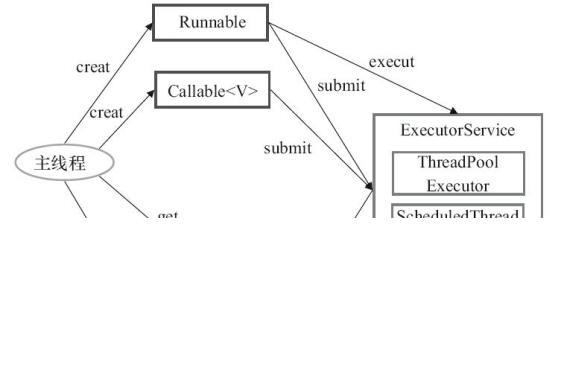
- 主线程首先要创建实现 Runnable 或者 Callable 接口的任务对象。
- 把创建完成的实现 Runnable/Callable接口的 对象直接交给 ExecutorService 执行 : ExecutorService.execute(Runnable command))或者也可以把 Runnable 对象或Callable 对象提交给 ExecutorService 执行(ExecutorService.submit(Runnable task)或 ExecutorService.submit(Callable <T> task))。
- 如果执行 ExecutorService.submit(…),ExecutorService 将返回一个实现Future接口的对象 (我们刚刚也提到过了执行 execute()方法和 submit()方法的区别,submit()会返回一个 FutureTask 对象)。由于 FutureTask 实现了 Runnable,我们也可以创建 FutureTask,然后直接交给 ExecutorService 执行。
- 最后,主线程可以执行 FutureTask.get()方法来等待任务执行完成。主线程也可以执行 FutureTask.cancel(boolean mayInterruptIfRunning)来取消此任务的执行。
三 (重要)ThreadPoolExecutor 类简单介绍
线程池实现类 ThreadPoolExecutor 是 Executor 框架最核心的类。
3.1 ThreadPoolExecutor 类分析
ThreadPoolExecutor 类中提供的四个构造方法。我们来看最长的那个,其余三个都是在这个构造方法的基础上产生(其他几个构造方法说白点都是给定某些默认参数的构造方法比如默认制定拒绝策略是什么),这里就不贴代码讲了,比较简单。
/** * 用给定的初始参数创建一个新的ThreadPoolExecutor。 */ public ThreadPoolExecutor(int corePoolSize,//线程池的核心线程数量 int maximumPoolSize,//线程池的最大线程数 long keepAliveTime,//当线程数大于核心线程数时,多余的空闲线程存活的最长时间 TimeUnit unit,//时间单位 BlockingQueue<Runnable> workQueue,//任务队列,用来储存等待执行任务的队列 ThreadFactory threadFactory,//线程工厂,用来创建线程,一般默认即可 RejectedExecutionHandler handler//拒绝策略,当提交的任务过多而不能及时处理时,我们可以定制策略来处理任务 ) { if (corePoolSize < 0 || maximumPoolSize <= 0 || maximumPoolSize < corePoolSize || keepAliveTime < 0) throw new IllegalArgumentException(); if (workQueue == null || threadFactory == null || handler == null) throw new NullPointerException(); this.corePoolSize = corePoolSize; this.maximumPoolSize = maximumPoolSize; this.workQueue = workQueue; this.keepAliveTime = unit.toNanos(keepAliveTime); this.threadFactory = threadFactory; this.handler = handler; }复制代码
下面这些对创建 非常重要,在后面使用线程池的过程中你一定会用到!所以,务必拿着小本本记清楚。
ThreadPoolExecutor 3 个最重要的参数:
- corePoolSize : 核心线程数线程数定义了最小可以同时运行的线程数量。
- maximumPoolSize : 当队列中存放的任务达到队列容量的时候,当前可以同时运行的线程数量变为最大线程数。
- workQueue: 当新任务来的时候会先判断当前运行的线程数量是否达到核心线程数,如果达到的话,信任就会被存放在队列中。
ThreadPoolExecutor其他常见参数:
- keepAliveTime :当线程池中的线程数量大于 corePoolSize 的时候,如果这时没有新的任务提交,核心线程外的线程不会立即销毁,而是会等待,直到等待的时间超过了 keepAliveTime才会被回收销毁;
- unit : keepAliveTime 参数的时间单位。
- threadFactory :executor 创建新线程的时候会用到。
- handler :饱和策略。关于饱和策略下面单独介绍一下。
下面这张图可以加深你对线程池中各个参数的相互关系的理解(图片来源:《Java性能调优实战》):
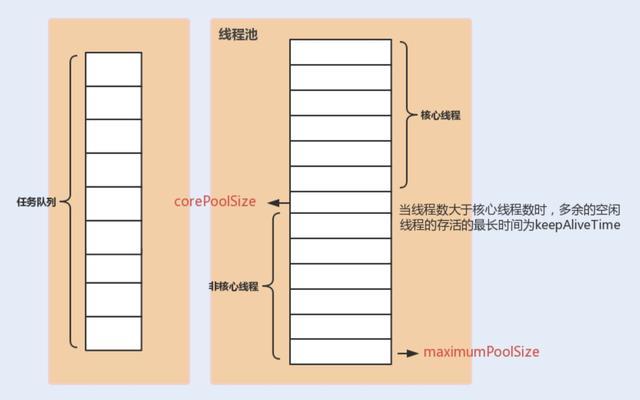
ThreadPoolExecutor 饱和策略定义:
如果当前同时运行的线程数量达到最大线程数量并且队列也已经被放满了任时,ThreadPoolTaskExecutor 定义一些策略:
- ThreadPoolExecutor.AbortPolicy :抛出 RejectedExecutionException来拒绝新任务的处理。
- ThreadPoolExecutor.CallerRunsPolicy :调用执行自己的线程运行任务。您不会任务请求。但是这种策略会降低对于新任务提交速度,影响程序的整体性能。另外,这个策略喜欢增加队列容量。如果您的应用程序可以承受此延迟并且你不能任务丢弃任何一个任务请求的话,你可以选择这个策略。
- ThreadPoolExecutor.DiscardPolicy: 不处理新任务,直接丢弃掉。
- ThreadPoolExecutor.DiscardOldestPolicy: 此策略将丢弃最早的未处理的任务请求。
举个例子:
Spring 通过 ThreadPoolTaskExecutor 或者我们直接通过 ThreadPoolExecutor 的构造函数创建线程池的时候,当我们不指定 RejectedExecutionHandler 饱和策略的话来配置线程池的时候默认使用的是 ThreadPoolExecutor.AbortPolicy。在默认情况下,ThreadPoolExecutor 将抛出 RejectedExecutionException 来拒绝新来的任务 ,这代表你将丢失对这个任务的处理。 对于可伸缩的应用程序,建议使用 ThreadPoolExecutor.CallerRunsPolicy。当最大池被填满时,此策略为我们提供可伸缩队列。(这个直接查看 ThreadPoolExecutor 的构造函数源码就可以看出,比较简单的原因,这里就不贴代码了。)
3.2 推荐使用 ThreadPoolExecutor 构造函数创建线程池
在《阿里巴巴 Java 开发手册》“并发处理”这一章节,明确指出线程资源必须通过线程池提供,不允许在应用中自行显示创建线程。
为什么呢?
使用线程池的好处是减少在创建和销毁线程上所消耗的时间以及系统资源开销,解决资源不足的问题。如果不使用线程池,有可能会造成系统创建大量同类线程而导致消耗完内存或者“过度切换”的问题。
另外《阿里巴巴 Java 开发手册》中强制线程池不允许使用 Executors 去创建,而是通过 ThreadPoolExecutor 构造函数的方式,这样的处理方式让写的同学更加明确线程池的运行规则,规避资源耗尽的风险
Executors 返回线程池对象的弊端如下:
FixedThreadPool 和 SingleThreadExecutor : 允许请求的队列长度为 Integer.MAX_VALUE,可能堆积大量的请求,从而导致 OOM。 CachedThreadPool 和 ScheduledThreadPool : 允许创建的线程数量为 Integer.MAX_VALUE ,可能会创建大量线程,从而导致 OOM。
方式一:通过ThreadPoolExecutor构造函数实现(推荐)

方式二:通过 Executor 框架的工具类 Executors 来实现 我们可以创建三种类型的 ThreadPoolExecutor:
- FixedThreadPool
- SingleThreadExecutor
- CachedThreadPool
对应 Executors 工具类中的方法如图所示:
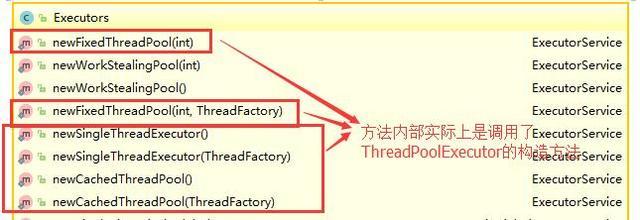
四. 几种常见的线程池详解
4.1 FixedThreadPool
4.1.1 介绍
FixedThreadPool 被称为可重用固定线程数的线程池。通过 Executors 类中的相关源代码来看一下相关实现:
/** * 创建一个可重用固定数量线程的线程池 */ public static ExecutorService newFixedThreadPool(int nThreads, ThreadFactory threadFactory) { return new ThreadPoolExecutor(nThreads, nThreads, 0L, TimeUnit.MILLISECONDS, new LinkedBlockingQueue<Runnable>(), threadFactory); }复制代码
另外还有一个 FixedThreadPool 的实现方法,和上面的类似,所以这里不多做阐述:
public static ExecutorService newFixedThreadPool(int nThreads) { return new ThreadPoolExecutor(nThreads, nThreads, 0L, TimeUnit.MILLISECONDS, new LinkedBlockingQueue<Runnable>()); }复制代码
从上面源代码可以看出新创建的 FixedThreadPool 的 corePoolSize 和 maximumPoolSize 都被设置为 nThreads,这个 nThreads 参数是我们使用的时候自己传递的。
4.1.2 执行任务过程介绍
FixedThreadPool 的 execute() 方法运行示意图:

上图说明:
- 如果当前运行的线程数小于 corePoolSize, 如果再来新任务的话,就创建新的线程来执行任务;
- 当前运行的线程数等于 corePoolSize 后, 如果再来新任务的话,会将任务加入 LinkedBlockingQueue;
- 线程池中的线程执行完 手头的任务后,会在循环中反复从 LinkedBlockingQueue 中获取任务来执行;
4.1.3 为什么不推荐使用FixedThreadPool?
FixedThreadPool 使用无界队列 LinkedBlockingQueue(队列的容量为 Intger.MAX_VALUE)作为线程池的工作队列会对线程池带来如下影响 :
- 当线程池中的线程数达到 corePoolSize 后,新任务将在无界队列中等待,因此线程池中的线程数不会超过 corePoolSize;
- 由于使用无界队列时 maximumPoolSize 将是一个无效参数,因为不可能存在任务队列满的情况。所以,通过创建 FixedThreadPool的源码可以看出创建的 FixedThreadPool 的 corePoolSize 和 maximumPoolSize 被设置为同一个值。
- 由于 1 和 2,使用无界队列时 keepAliveTime 将是一个无效参数;
- 运行中的 FixedThreadPool(未执行 shutdown()或 shutdownNow())不会拒绝任务,在任务比较多的时候会导致 OOM(内存溢出)。
4.2 SingleThreadExecutor 详解
4.2.1 介绍
SingleThreadExecutor 是只有一个线程的线程池。下面看看 SingleThreadExecutor 的实现:
/** *返回只有一个线程的线程池 */ public static ExecutorService newSingleThreadExecutor(ThreadFactory threadFactory) { return new FinalizableDelegatedExecutorService (new ThreadPoolExecutor(1, 1, 0L, TimeUnit.MILLISECONDS, new LinkedBlockingQueue<Runnable>(), threadFactory)); }复制代码
public static ExecutorService newSingleThreadExecutor() { return new FinalizableDelegatedExecutorService (new ThreadPoolExecutor(1, 1, 0L, TimeUnit.MILLISECONDS, new LinkedBlockingQueue<Runnable>())); }复制代码
从上面源代码可以看出新创建的 SingleThreadExecutor 的 corePoolSize 和 maximumPoolSize 都被设置为 1.其他参数和 FixedThreadPool 相同。
4.2.2 执行任务过程介绍
SingleThreadExecutor 的运行示意图:
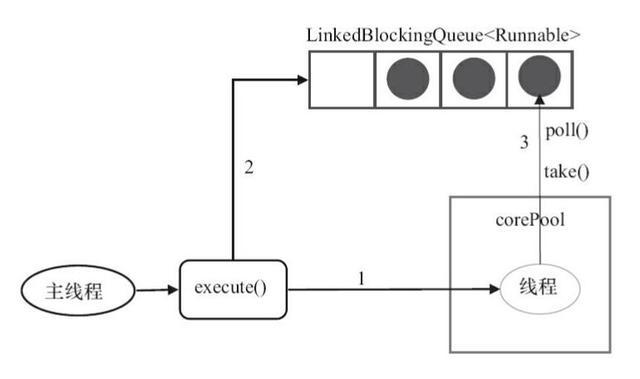
上图说明;
- 如果当前运行的线程数少于 corePoolSize,则创建一个新的线程执行任务;
- 当前线程池中有一个运行的线程后,将任务加入 LinkedBlockingQueue
- 线程执行完当前的任务后,会在循环中反复从 LinkedBlockingQueue 中获取任务来执行;
4.2.3 为什么不推荐使用FixedThreadPool?
SingleThreadExecutor 使用无界队列 LinkedBlockingQueue 作为线程池的工作队列(队列的容量为 Intger.MAX_VALUE)。SingleThreadExecutor 使用无界队列作为线程池的工作队列会对线程池带来的影响与 FixedThreadPool 相同。说简单点就是可能会导致 OOM,
4.3 CachedThreadPool 详解
4.3.1 介绍
CachedThreadPool 是一个会根据需要创建新线程的线程池。下面通过源码来看看 CachedThreadPool 的实现:
/** * 创建一个线程池,根据需要创建新线程,但会在先前构建的线程可用时重用它。 */ public static ExecutorService newCachedThreadPool(ThreadFactory threadFactory) { return new ThreadPoolExecutor(0, Integer.MAX_VALUE, 60L, TimeUnit.SECONDS, new SynchronousQueue<Runnable>(), threadFactory); }复制代码
public static ExecutorService newCachedThreadPool() { return new ThreadPoolExecutor(0, Integer.MAX_VALUE, 60L, TimeUnit.SECONDS, new SynchronousQueue<Runnable>()); }复制代码
CachedThreadPool 的 corePoolSize 被设置为空(0),maximumPoolSize 被设置为 Integer.MAX.VALUE,即它是无界的,这也就意味着如果主线程提交任务的速度高于 maximumPool 中线程处理任务的速度时,CachedThreadPool 会不断创建新的线程。极端情况下,这样会导致耗尽 cpu 和内存资源。
4.3.2 执行任务过程介绍
CachedThreadPool 的 execute()方法的执行示意图:
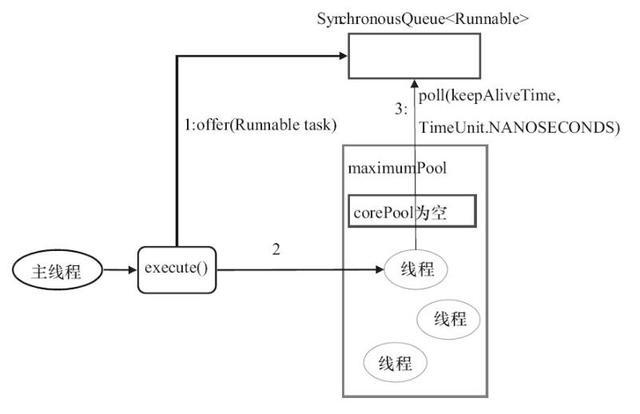
上图说明:
- 首先执行 SynchronousQueue.offer(Runnable task) 提交任务到任务队列。如果当前 maximumPool 中有闲线程正在执行 SynchronousQueue.poll(keepAliveTime,TimeUnit.NANOSECONDS),那么主线程执行 offer 操作与空闲线程执行的 poll 操作配对成功,主线程把任务交给空闲线程执行,execute()方法执行完成,否则执行下面的步骤 2;
- 当初始 maximumPool 为空,或者 maximumPool 中没有空闲线程时,将没有线程执行 SynchronousQueue.poll(keepAliveTime,TimeUnit.NANOSECONDS)。这种情况下,步骤 1 将失败,此时 CachedThreadPool会创建新线程执行任务,execute 方法执行完成;
4.3.3 为什么不推荐使用CachedThreadPool?
CachedThreadPool允许创建的线程数量为 Integer.MAX_VALUE ,可能会创建大量线程,从而导致 OOM。
记得关注(下篇)已经给大家准备好了
欢迎大家点赞关注转发一起来讨论。会每天给大家带来一到两个知识点,一起成长。












![[HBLOG]公众号](https://www.liuhaihua.cn/img/qrcode_gzh.jpg)

